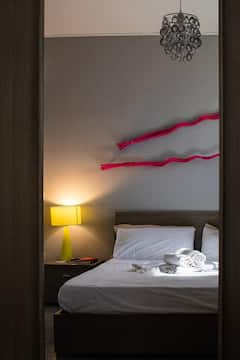The Italian countryside rolls by the window. Occasionally, sections of the ancient Roman aqueduct are visible from the train. Everywhere, fields glow in the sunlight. As you get close, the greater Naples metropolis sprawls beneath Mount Vesuvius, a living volcano. The modern city of Pompei surrounds the ancient one: first and twenty-first centuries butt against each other in a vertigo of time and space. Archeological digging began in 1748, and Pompeii has been a popular tourist destination ever since. The preserved city is a chance to see the ancient Roman Empire, frozen in time, on a grand scale.
Getting to Pompei

The easiest way to reach Pompeii is by rail. TrenItalia runs from Rome to modern Pompei. Trip time varies: the 150 miles can take as little as 2 hours. Pompei’s station is about a 20 minute walk from the archeological site. Conversely, you can switch train systems in Naples. The Circumvesuviana line stops close to Pompeii’s main entrance. It also stops at the four other major archeological sites in the area: Herculaneum, Oplontis, Stabiae, and Boscoreale. Purchase TrenItalia tickets ahead on their user-friendly website. Circumvesuviana tickets require cash, either at the station or one of the nearby newsstands. Prices for both rails vary.
Tour packages are available through various vendors. If you like guided tours, or exploring with other people, packages for day-trips from Rome, or Naples, are popular.
The biggest decision to make is how long to stay. Many tourists visit for a few hours and catch highlights, but to see it all, you’ll need more than one day. Each of the four other excavations in the region offer unique treasures. And you can hike up the mountain, both for the view and for the thrill of peering into a dangerous volcano; the easy climb takes about an hour round trip. Pompeii itself is a large complex of streets, buildings and gardens. At the northeast end are two ancient villas. The Villa of the Mysteries is especially charming because most of its frescoes survived intact, including those depicting scenes of the Dionysian Mysteries.
Tickets can be purchased for each of the archeological locations, or packaged all in one for a three-day inclusive pass. A Pompeii ticket is around 13 EUR (14.51 USD), while the package is about 22 EUR (24.55 USD) – prices vary.
Keep cool in the triangular forum

Pompeii is beautiful, and HOT. The grounds are exposed to sunlight all day long. Be sure to wear cool clothing, and pack necessaries like big hats and sunscreen. Some of the buildings are open, and provide welcome shade as you wind through the city. But the primary source of cool refuge is the Triangular Forum, near the Grand Theatre. Here you can shelter under a thick canopy of trees. Savvy tourists plan ahead and pack a lunch, and picnic here. (You can’t leave and come back without buying a second ticket.)
Stay hydrated; Pompeii was plumbed better in C.E. 79

In the spirit of Rome’s love for complex city water planning, Pompeii’s ancient plumbing was a work of genius; the gravity feed was designed so that in times of drought, water shortages would occur at the superfluous water features first, and the 25 essential municipal water fountains last. And while the pipes of ancient water lines and drains are everywhere visible, modern plumbing is sparse. There are only two restrooms in Pompeii, one at the main entrance, and one in the city center.
Like Rome, some of Pompeii’s fountains have been restored and maintained. Some of the ancient spouts have been updated with water spigots. Start the day toting in your own water, then refill your bottles at the working spigots.
In order to stay comfortable, it’s advisable to bring chilled water with you. The eateries clustered around Pompeii’s gates sell frozen bottled water, and it’s worth the expense; you can have cold water for as long as it takes to melt. The small luxury will make all the difference as you gaze on all the wonders of a city so well preserved it feels wrong to call it “ruins.”
You might be interested in these Airbnbs!
Take In the spectacle of colliding centuries

Pompeii is a site of temporal confusion. From the top of the Grand Theatre, the view extends past the open green of the palisade and through picturesque trees. But the line of sight to the distant mountains is interrupted by modern buildings. Unlike Rome, whose growth accreted in layers over the old, Pompeii just stopped, forgotten. The line between ancient and modern is abrupt. The historic city is still intact enough to feel relevant, were it not for telltale modernity nearly leaning on its walls.
Adding to this time-distortion, when events are held in Pompeii, all the modern rigging and lighting of 21st century concert culture are brought in. Electronic sound reverberates over ancient stones. High output theatre lights cut through a sky that once held only stars.
Yet this contrast is oddly stimulating – the mind gets a sense of how space breathes across time; you’re peering through centuries, epochs knitted in a glance. The newer edifices will eventually crumble, while this ancient city will hold out for a while longer. Of course, there’s always the chance that Vesuvius has other plans.
Just BE in the space
When you visit, climb to a high place. Look across the ancient buildings and the landscape. To the north, Vesuvius still steams a promise that she will not yet sleep; to the south and west, modern Pompei sprawls cheerfully in the sunlight. This is a city 8,000 years old. As you peer out across the horizon, you see a landscape not much changed in all that time.
History
Get Trip101 in your inbox
Unsubscribe in one click. See our Privacy Policy for more information on how we use your data




















Create an account to